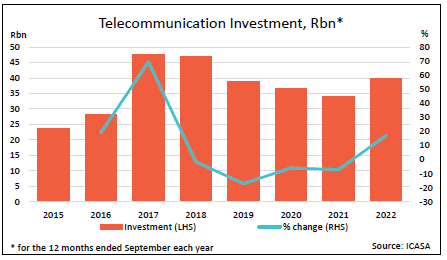Telecommunications: a catalyst in African economic development
The role of telecommunications in driving economic development
Telecommunications serves as a backbone of modern economies and underpins various industries that are essential for economic activities, from financial services, software development and ecommerce to media and entertainment. Telecoms operate in the backroom of what are considered the magnificent seven viz. Apple, Amazon, Alphabet, Microsoft, Meta, Tesla and Nvidia. Nvidia is known for its contribution to AI acceleration, edge computing and virtualisation found in telecommunications technologies.
While companies such as Nvidia are driving new technologies, access to and distribution of all information generated, including by AI, is via telecommunications in mobile, fibre or traditional fixed line operations. Telecommunications companies haven’t shared the limelight with the magnificent seven, but are equally important to sustain the progress in software development.
Unlike AI and software development, which rely on human capital, telecommunications is more capital intensive.
Challenges in the African telecommunications industry
In Africa, challenges of access and insufficient telecommunications infrastructure remain, with some remote areas still not covered by terrestrial infrastructure, mostly affecting low to middle income groups, and consequential lower spending in less densely populated areas means the expected return on high capital investment remain relatively low. However, it is notable that the sector has seen great progress in Africa with over 1.1 billion unique mobile subscribers in 2020, accounting for around 84% of the population covered by mobile networks. Telecommunications continues to play a crucial role in driving economic development across the continent.
The availability of the latest ICT infrastructure in African countries is however still lagging. For example, as reported in WOW’s ICT and Telecommunications Industry in Ghana report, 3G is widely used on 90% of voice calls, with latency (delay in establishing connection) poor in most cases. MTN and Vodafone offer 4G coverage 66% and 54% of the time respectively. This is representative of most African countries on the higher end of the development scale, as Ghana is relatively well positioned in relation to other African countries.
Addressing the digital divide
The digital divide is still a reality on the African continent, where a lack of digital literacy and technical skills inhibits the effective adoption and utilisation of new technologies. Education systems are still grappling with adequately preparing students with the digital skills needed to thrive in technology-driven economies, limiting opportunities for innovation, entrepreneurship, and technology adoption.
South Africa, as the most industrialised country in Africa, ranks well in telecoms availability as it has benefited from huge investments by private sector operators. This is illustrated in the WOW report on Telecommunications and Retail of Electronic Devices in South Africa, which includes the graphs above.
Competitiveness in South Africa’s telecommunications sector
Revenue growth has followed this investment, but ongoing technological developments and innovation will require continued investments in, for example, 5G and fibre connections. Telkom’s legacy fixed line voice revenue continues to decline, as illustrated in the graph above, restricting its ability to fund new investments.
Openserve (owned by Telkom) has approximately 165,900km of fibre optic network cable, followed by Vumatel with around 50,000km, meaning that Telkom has three times Vumatel’s network and yet according to information in the WOW telecommunications report, Vumatel has the largest network by homes passed (households that have access to a particular network) at 2 million, while Openserve announced over 1.1 million homes passed by June 2023.
According to a report by Africa Bandwidth Maps, as of June 2023, the total length of operational fibre optic network in South Africa was 1,279,026km, increasing by 36.6% from 936,102km in 2018 and 143.7% from 524,847km in 2013. The report said an additional 94,998km of fibre optic network entered service in the 12 months since June 2022, an average of 260km of new fibre optic network per day.
Conclusion
The sector has been plagued by regulatory inefficiencies and delays in migrating from analogue to digital broadcasting, with government missing an opportunity to avail infrastructure opportunities that could have contributed to economic activity among the small players in the sector. Despite the challenges, it is evident that there is resilience and competition that fosters innovation and drives the expansion of network infrastructure. It is not unreasonable to infer that this is driven by the money to be made.
In the wider sense, telecommunication has been and continues to be a significant engine for GDP growth and wealth creation for individuals with better and wider access to communications via smartphones and other devices, which can provide people in rural areas access to the internet, and market places for products and services.
South Africa can look forward to even better and faster access and affordability of telecommunications.
Contact us to access WOW's quality research on African industries and business
Contact UsRelated Articles
BlogCountries Information and communicationSouth Africa
The AI Revolution in South Africa: Navigating the Unstoppable Tech Wave
Contents [hide] Tech trends in South Africa, like all over the world, are dominated by artificial intelligence (AI). As usual, initial reactions to new technology are often optimistic. The revolutionary...
BlogCountries Information and communicationSouth Africa
The Impact of streaming on music industry earnings in South Africa
Contents [hide] Historical evolution of the music industry From the revered gramophone, which was the first instrument capable of reproducing music and storing it on a flat disk, invented by...
BlogCountries Information and communicationSouth Africa
The rapid transformation of household internet access in South Africa
Contents [hide] History of internet access in South Africa As with most innovations, internet access was relatively expensive when it was first introduced. Sources of information available were much more...







